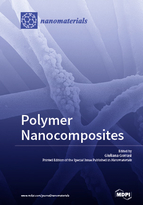Polymer Nanocomposites
A special issue of Nanomaterials (ISSN 2079-4991).
Deadline for manuscript submissions: closed (30 November 2017) | Viewed by 84923
Special Issue Editor
Interests: green nanomaterials; polymer characterization; nanoclay; composites; mechanical properties; nanofibers
Special Issues, Collections and Topics in MDPI journals
Special Issue Information
Dear Colleagues,
Over the last two decades, nanoscience and nanotechnologies have been creating new opportunities for producing materials with surprisingly unusual properties. The possibility of manipulating materials, on an atomic or molecular level, allows the possibility of obtaining structures that possess unique characteristics and completely new functionalities. The use of nanoparticles to produce polymer nanocomposites, with desired structures and functionalities, has recently also attracted significant research interests. They can be used, not only as for structural purposes, but also as functional nano-structures in many fields, such as microelectronics, packaging, drug delivery, flame retardant materials, and environmental issues. A number of interesting nanoparticles, such as clays (lamellar or tubular), silica, carbon nanotubes, siloxanes, and, more recently, graphenes, have emerged as peculiar nanofillers for enhancing the performance of polymer matrices for a wide variety of technological applications.
The present Special Issue on “Polymer Nanocomposites” aims to publish original research, which either adds knowledge to the current understanding on polymer nanocomposites, or proposes technological innovations associated with these materials. Critical reviews are also welcome.
It is my pleasure to invite you to submit a manuscript to this Special Issue.
Prof. Giuliana Gorrasi
Guest Editor
Manuscript Submission Information
Manuscripts should be submitted online at www.mdpi.com by registering and logging in to this website. Once you are registered, click here to go to the submission form. Manuscripts can be submitted until the deadline. All submissions that pass pre-check are peer-reviewed. Accepted papers will be published continuously in the journal (as soon as accepted) and will be listed together on the special issue website. Research articles, review articles as well as short communications are invited. For planned papers, a title and short abstract (about 100 words) can be sent to the Editorial Office for announcement on this website.
Submitted manuscripts should not have been published previously, nor be under consideration for publication elsewhere (except conference proceedings papers). All manuscripts are thoroughly refereed through a single-blind peer-review process. A guide for authors and other relevant information for submission of manuscripts is available on the Instructions for Authors page. Nanomaterials is an international peer-reviewed open access semimonthly journal published by MDPI.
Please visit the Instructions for Authors page before submitting a manuscript. The Article Processing Charge (APC) for publication in this open access journal is 2900 CHF (Swiss Francs). Submitted papers should be well formatted and use good English. Authors may use MDPI's English editing service prior to publication or during author revisions.
Keywords
- Nanocomposites
- Polymer
- Clays
- Nanoparticles
- Modification







